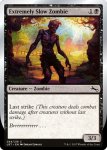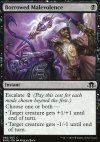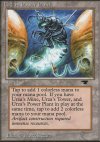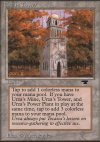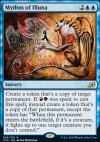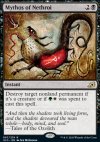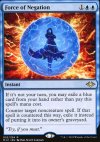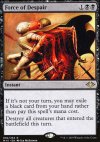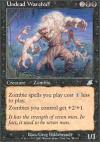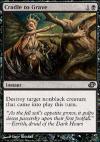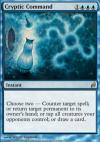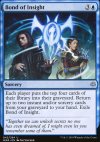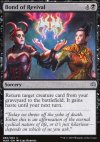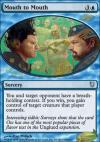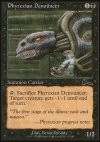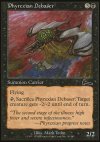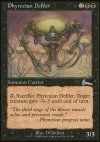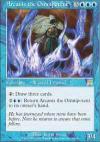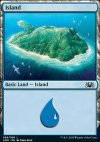|

MV anecdotes
| 953 anecdotes trouvées |   |
Les quatre illustrations d'Extremely Slow Zombie (en dehors du sens comique de sa rapidité, en poussant le cri du zombie sur quatre saisons) sont une référence à celles de Mishra's Factory de l'édition Antiquities (voir cette anecdote).
Les trois cartes Borrowed Grace, Borrowed Malevolence et Borrowed Hostility, de l'édition Eldritch Moon et illustrées par Volkan Baga, forment un cycle appelé "Borrowed -".
Les trois cartes Urza's Mine, Urza's Power Plant et Urza's Tower, de l'édition Antiquities, forment un cycle appelé "Urzatron" (ou "Tron" en abrégé). Ce terme provient de la série TV animée Voltron, ultrapopulaire au Japon, dans laquelle des robots s'assemblent pour former un robot surpuissant.
Source 1 ("@maro254 did meld always just use 2 cards, or were there designs that used more. was there a voltron-esque design") - Source 2 (Question #5 - "Interestingly, four of the land subtypes come from a three-card cycle (Urza's Mine, Urza's Power Plant, and Urza's Tower—known as the Urzatron) from Magic's second expansion, Antiquities.")
Source 1 ("@maro254 did meld always just use 2 cards, or were there designs that used more. was there a voltron-esque design") - Source 2 (Question #5 - "Interestingly, four of the land subtypes come from a three-card cycle (Urza's Mine, Urza's Power Plant, and Urza's Tower—known as the Urzatron) from Magic's second expansion, Antiquities.")
Le cycle appelé "ultimatums", des rituels tricolores dont le coût de mana (valeur de sept manas au total) est uniquement composé de manas colorés, commencé avec cinq cartes dans l'édition Shard of Alara, a été terminé 12 ans plus tard avec l'édition Ikoria: Lair of Behemoths.
Shards of Alara :
• Clarion Ultimatum
• Brilliant Ultimatum
• Cruel Ultimatum
• Violent Ultimatum
• Titanic Ultimatum
Ikoria: Lair of Behemoths :
• Ruinous Ultimatum
• Genesis Ultimatum
• Eerie Ultimatum
• Inspired Ultimatum
• Emergent Ultimatum
Source (Cruel Ultimatum - "Often in design we see a card we like so much that it inspires a cycle. Cruel Ultimatum was the inspiration for the Ultimatum cycle.")
Shards of Alara :
• Clarion Ultimatum
• Brilliant Ultimatum
• Cruel Ultimatum
• Violent Ultimatum
• Titanic Ultimatum
Ikoria: Lair of Behemoths :
• Ruinous Ultimatum
• Genesis Ultimatum
• Eerie Ultimatum
• Inspired Ultimatum
• Emergent Ultimatum
Source (Cruel Ultimatum - "Often in design we see a card we like so much that it inspires a cycle. Cruel Ultimatum was the inspiration for the Ultimatum cycle.")
Les cinq cartes Mythos of Snapdax, Mythos of Illuna, Mythos of Nethroi, Mythos of Vadrok et Mythos of Brokkos, de l'édition Ikoria Lair of Behemoths, forment un cycle appelé "Mythos".
C'est le premier travail d'illustration non digitalisé réalisé par Seb McKinnon pour Magic. Il s'est inspiré des peintures de la grotte de Lascaux.
Source
C'est le premier travail d'illustration non digitalisé réalisé par Seb McKinnon pour Magic. Il s'est inspiré des peintures de la grotte de Lascaux.
Source
Les cinq cartes Force of Virtue, Force of Negation, Force of Despair, Force of Rage et Force of Vigor, de l'édition Modern Horizons, forment un cycle appelé "Force of -".
Le nom de ce cycle s'inspire de celui de la carte Force of Will qui fait partie d'un cycle similaire paru dans l'édition Alliances (voir cette anecdote), car cette carte est la plus connue et jouée du cycle.
Le nom de ce cycle s'inspire de celui de la carte Force of Will qui fait partie d'un cycle similaire paru dans l'édition Alliances (voir cette anecdote), car cette carte est la plus connue et jouée du cycle.
Les cinq cartes Staff of the Sun Magus, Staff of the Mind Magus, Staff of the Death Magus, Staff of the Flame Magus et Staff of the Wild Magus, illustrées par Daniel Ljunggren, forment un cycle appelé "Staff of the - Magus" et ont la particularité d'illustrer le symbole de mana de la couleur dont elles tirent leur effet.
Les cinq cartes Daru Warchief, Mistform Warchief, Undead Warchief, Krosan Warchief et Goblin Warchief, de l'édition Scourge, forment un cycle appelé "Warchief".
Chaque Chef de guerre porte sur lui un bijou de sa couleur.
Chaque Chef de guerre porte sur lui un bijou de sa couleur.
Les cartes Premature Burial, Cradle to Grave et Grave Peril forment un cycle. La première permet de détruire une créature du "passé", la deuxième, une créature du présent, et la troisième, une créature du "futur". Elles partagent aussi le même coût de mana et l'auteur des citations de tous leurs textes d'ambiance est Ezrith.
Les cinq cartes Marble Diamond, Sky Diamond, Charcoal Diamond, Fire Diamond et Moss Diamond, ainsi que les cartes Lion's Eye Diamond et Powerstone Shard, illustrées par Lindsey Look, forment un cycle d'illustrations.
Les cinq cartes Austere Command, Cryptic Command, Profane Command, Incendiary Command et Primal Command, de l'édition Lorwyn, forment un cycle appelé "Command" d'éphémères/rituels qui permettent de choisir deux effets parmi quatre.
Ce cycle a inspiré des cycles similaires, parus dans les éditions Dragons of Tarkir, Strixhaven School of Mages et The Brothers' War (voir respectivement cette anecdote, celle-ci et celle-là).
Les cartes Kozilek's Command et Your Wish Is My Command parues ensuite font référence à ce cycle.
Source (THE COMMAND CYCLE)
Ce cycle a inspiré des cycles similaires, parus dans les éditions Dragons of Tarkir, Strixhaven School of Mages et The Brothers' War (voir respectivement cette anecdote, celle-ci et celle-là).
Les cartes Kozilek's Command et Your Wish Is My Command parues ensuite font référence à ce cycle.
Source (THE COMMAND CYCLE)
THE COMMAND CYCLE a écrit :
[...] In Lorwyn, [Aaron Forsythe] made a cycle of cards he originally called Super Charms. The original Charms from Mirage were instants that allowed you to choose one of three small effects. The Charms were much beloved and we've done them again and again in many different incarnations. The Super Charms gave you four choices instead of three and let you choose two effects instead of one. The Commands, as they ended up being called, were a huge hit; Cryptic Command , the blue one, became a staple in many formats.
Les cinq cartes Dromoka's Command, Ojutai's Command, Silumgar's Command, Kolaghan's Command et Atarka's Command, de l'édition Dragons of Tarkir, forment un cycle appelé "Command" d'éphémères/rituels qui permettent de choisir deux effets parmi quatre.
Ce cycle est inspiré d'un autre cycle paru dans l'édition Lorwyn (voir cette anecdote).
Source (THE COMMAND CYCLE)
Ce cycle est inspiré d'un autre cycle paru dans l'édition Lorwyn (voir cette anecdote).
Source (THE COMMAND CYCLE)
THE COMMAND CYCLE a écrit :
[...] In Lorwyn, [Aaron Forsythe] made a cycle of cards he originally called Super Charms. [...] [Unlike the original Charms from Mirage,] The Super Charms gave you four choices instead of three and let you choose two effects instead of one. The Commands, as they ended up being called, were a huge hit; [...]
During Khans of Tarkir design, there was a lot of talk about doing three-color Commands. The problem was how do you make cards with four choices when there are three colors? The solution we came up with, as each wedge had a central color, was to let the main color get a second effect. But we knew that the last set was going to be two-color in theme and we'd never made multicolor Commands, so we thought possibly two-color would work better. That would allow two abilities to choose from for each color.
The Dragons of Tarkir design team tried a number of different cycles in this slot, but momentum kept pulling us back to doing Commands. It was just too good a fit to pass up. The five were obviously tied creatively to the five dragonlords.
During Khans of Tarkir design, there was a lot of talk about doing three-color Commands. The problem was how do you make cards with four choices when there are three colors? The solution we came up with, as each wedge had a central color, was to let the main color get a second effect. But we knew that the last set was going to be two-color in theme and we'd never made multicolor Commands, so we thought possibly two-color would work better. That would allow two abilities to choose from for each color.
The Dragons of Tarkir design team tried a number of different cycles in this slot, but momentum kept pulling us back to doing Commands. It was just too good a fit to pass up. The five were obviously tied creatively to the five dragonlords.
Les cinq cartes Bond of Discipline, Bond of Insight, Bond of Revival, Bond of Passion et Bond of Flourishing forment un cycle appelé "Bond" et qui illustre pour chacune l'alliance de deux guildes de Ravnica partageant une couleur. Sur chaque illustration, on peut voir les fusions de leurs symboles.
Parmi tous les cycles de cartes qui existent, l'édition Unhinged en propose un bien particulier avec les cinq cartes Head to Head, Mouth to Mouth, Eye to Eye, Face to Face et Side to Side : il s'agira de faire un mini-jeu pendant une partie de Magic.
Source (#27. Shall We Play a Game)
Source (#27. Shall We Play a Game)
La carte Avatar of Me est la version parodique des cinq cartes Avatar of Fury, Avatar of Hope, Avatar of Might, Avatar of Will et Avatar of Woe, elle fait également référence dans son concept à Personal Incarnation.
Il existe cinq créatures de type Propagateur, ou "Carrier" en anglais. Les textes d'ambiance de ces monstres de Phyrexia décrivent l'avancement de leurs recherches en matière de Peste artificielle (Engineered Plague) tandis que leurs statistiques et capacités s'améliorent : Phyrexian Denouncer, Phyrexian Debaser, Phyrexian Defiler, Phyrexian Plaguelord et enfin Plague Engineer.
Les cinq cartes Jareth, Leonine Titan, Arcanis the Omnipotent, Visara the Dreadful, Rorix Bladewing et Silvos, Rogue Elemental, de l'édition Onslaught, forment un cycle appelé "Pit Fighter Legends". Ces légendes ont triomphé dans le Grand Coliseum, qui est une arène gérée par le Cabal Patriarch.
On peut d'ailleurs voir le Grand Coliseum sur les illustrations de trois des cinq légendes.
Source 1 - Source 2
On peut d'ailleurs voir le Grand Coliseum sur les illustrations de trois des cinq légendes.
Source 1 - Source 2
La carte Primevals' Glorious Rebirth est l'histoire de Darigaaz, the Igniter et des autres dragons primitifs Rith, the Awakener, Treva, the Renewer et Dromar, the Banisher qui se sacrifient pour ressusciter leur dernier membre Crosis, the Purger, qui à son tour va tous les ressusciter, complétant ainsi le panthéon et débloquant leurs pouvoirs divins.
Les cinq cartes Plains, Island, Swamp, Mountain et Forest, de l'édition Dominaria et illustrées par Titus Lunter, montrent le Weatherlight volant dans le ciel, mais le plus remarquable se trouve sur le Swamp où l'on peut voir la carcasse du Predator, Flagship.
La carte Magus of the Disk est une référence à Nevinyrral's Disk de par son nom, sa valeur de mana, sa capacité activée et son illustration.
En effet, sur l'illustration de Magus of the Disk, on peut le voir porter le disque à son cou.
En effet, sur l'illustration de Magus of the Disk, on peut le voir porter le disque à son cou.
La carte Magus of the Jar est une référence à Memory Jar de par son nom, sa valeur de mana, sa capacité activée et son illustration.
La carte Magus of the Mirror est une référence à Mirror Universe de par son nom, sa valeur de mana, sa capacité activée et son illustration.
La carte Magus of the Scroll est une référence à Cursed Scroll de par son nom, sa valeur de mana, sa capacité activée et son illustration. Elle est la version créature de cet artefact.
| 953 anecdotes trouvées |   |






 Tarkir: Dragonstorm
Tarkir: Dragonstorm Aetherdrift
Aetherdrift Foundations
Foundations Duskmourn
Duskmourn Bloomburrow
Bloomburrow Modern Horizons III
Modern Horizons III Outlaws of Thunder Junction
Outlaws of Thunder Junction